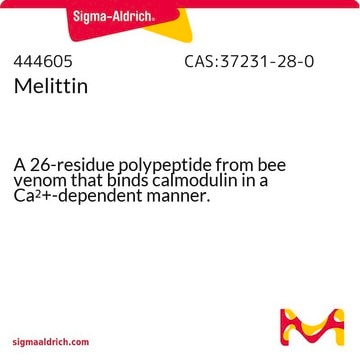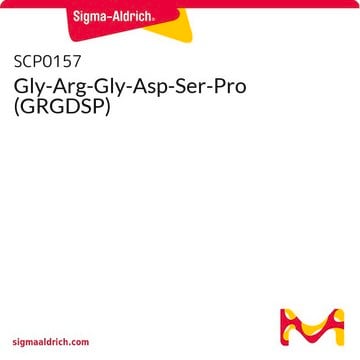N9039
nanoHA™7
low endotoxin
Anmeldenzur Ansicht organisationsspezifischer und vertraglich vereinbarter Preise
Alle Fotos(1)
About This Item
UNSPSC-Code:
12352201
Empfohlene Produkte
Form
film
Qualität
low endotoxin
Verunreinigungen
≤1 EU/mg endotoxin
Lagertemp.
−20°C
Allgemeine Beschreibung
The nanoHA products are small-molecular weight hyaluronic acid oligomers prepared by chemoenzymatic synthesis using immobilized enzymes. The name of each nanoHA indicates the number of monosaccharide units in the oligomer. The reducing end contains N-acetyl-D-glucosamine.
Anwendung
NanoHA has been used in a study to assess the nanomechanical properties of electrospun composite scaffolds. It has also been used in a study to investigate the influence of crystallite size of nanophased hydroxyapatite on fibronectin and osteonectin adsorption and on osteoblast adhesion and morphology.
Sonstige Hinweise
nanoHA7 is a heptasaccharide containing three hyaluronan disaccharide subunits (GlcNAcβ4GlcAβ3GlcNAcβ4GlcAβ3GlcNAcβ4GlcAβ3GlcNAcβ4).
To gain a comprehensive understanding of our extensive range of Oligosaccharides for your research, we encourage you to visit our Carbohydrates Category page.
Physikalische Form
Supplied lyophilized as the ammonium and/or sodium salt.
Hinweis zur Analyse
Sold on the basis of carbohydrate as determined by carbazole assay.
Rechtliche Hinweise
nanoHA is a trademark of Hyalose LLC
Lagerklassenschlüssel
11 - Combustible Solids
WGK
WGK 3
Flammpunkt (°F)
Not applicable
Flammpunkt (°C)
Not applicable
Hier finden Sie alle aktuellen Versionen:
Analysenzertifikate (COA)
Lot/Batch Number
Die passende Version wird nicht angezeigt?
Wenn Sie eine bestimmte Version benötigen, können Sie anhand der Lot- oder Chargennummer nach einem spezifischen Zertifikat suchen.
Besitzen Sie dieses Produkt bereits?
In der Dokumentenbibliothek finden Sie die Dokumentation zu den Produkten, die Sie kürzlich erworben haben.
Parul Tyagi et al.
Journal of nanoscience and nanotechnology, 9(8), 4839-4845 (2009-11-26)
Fibrous nanocomposite scaffolds were electrospun from dispersions of hydroxyapatite nanoparticles (nanoHA) in polycaprolactone (PCL) with varying nanoHA contents (from 0% to 50% by weight). Such scaffolds were produced to mimic the nano-features of the extracellular matrix (ECM) for natural bone
N Ribeiro et al.
Journal of colloid and interface science, 351(2), 398-406 (2010-09-03)
The characteristic topographical features (crystallite dimensions, surface morphology and roughness) of bioceramics may influence the adsorption of proteins relevant to bone regeneration. This work aims at analyzing the influence of two distinct nanophased hydroxyapatite (HA) ceramics, HA725 and HA1000 on
Staphylococcus aureus and Staphylococcus epidermidis adhesion to nanohydroxyapatite in the presence of model proteins
Ribeiro, M., et al.
Bio-medical materials and engineering, 7, 045010-045010 (2012)
Unser Team von Wissenschaftlern verfügt über Erfahrung in allen Forschungsbereichen einschließlich Life Science, Materialwissenschaften, chemischer Synthese, Chromatographie, Analytik und vielen mehr..
Setzen Sie sich mit dem technischen Dienst in Verbindung.






